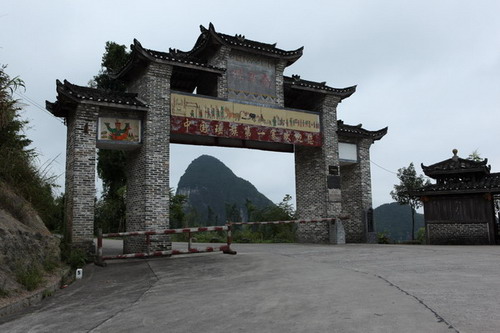 |
|
Lianshan Zhuang and Yao autonomous county lies at the northwestern corner of Guangdong province and the southern foot of Nanling Mountains.
|
Lying at the northwestern corner of Guangdong province and the southern foot of Nanling Mountains, Lianshan Zhuang and Yao autonomous county connects the Liannan Yao autonomous county in the east, Huaiji county in the south, Babu district, Hezhou city, Guangxi Zhuang Autonomous Region in the west and Jianghua Yao autonomous county, Hebei province in the north.
The county has an area of 1,265 square kilometers. Mountains, arable land and waters account for 86.6%, 5.7% and 7.7% of the territory, respectively. By the end of 2009, the county registered a total population of 115,800 people, including 72,100 minority people. It is the only autonomous county with settlements of Zhuang and Yao peoples in China. It is also one of the “100 best counties” in China in terms of forestry, an advanced sports county in China and a state-level Chinese medicinal herb planting base.
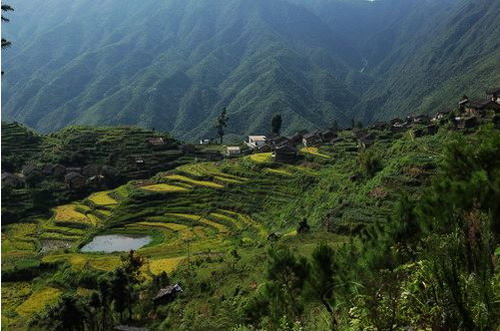 |
|
Arable land accounts for 5.7% of the territory. It is one of the “100 best counties” in China in terms of forestry and a state-level Chinese medicinal herb planting base.
|
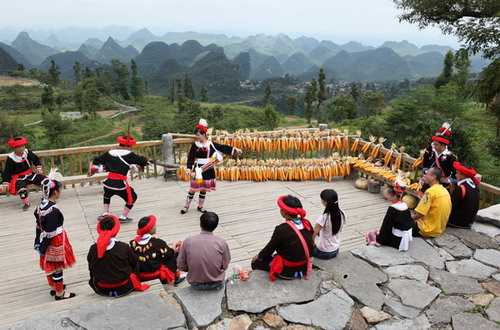 |
|
By the end of 2009, the county registered a total population of 115,800 people, including 72,100 minority people. It is the only autonomous county with settlements of Zhuang and Yao peoples in China.
|
Lianshan has a long history. The territory of the county first belonged to Chu State during the Zhou Dynasty, then to Changsha prefecture during the Qin Dynasty, to Guiyang prefecture during the Han Dynasty and to Shixing prefecture during the Jin Dynasty, and became a county in the fifth year of Emperor Tianjian’s reign in Liang State during the Southern Dynasties (506). Later on, it was renamed Guangde, Guangze, Lianshan and Chengshan county. In the 15th year of Emperor Zhiyuan’s reign (1278) during the Yuan Dynasty, it resumed the name of Lianshan. This name has been used consistently since then. The county government was first set in Guxianping, Chengshan, Xiaoshuiping, Yongheping and Jitian Lianhuaping. On December 20, 1949, Lianshan County People’s Government was founded. On September 26, 1962, the Lianshan Zhuang and Yao autonomous counties were founded. It was first placed under the administration of North Guangdong Administrative Office, Shaoguan Region and Shaoguan city. In January 1988, it was brought under the jurisdiction of the newly established Qingyuan city. In 2007, the county administered 7 towns, 46 village committees and 4 neighborhood committees, and the county government was located in Jitian town. Guangdong Provincial Lianshan Forest Farm is in this county.
Lianshan is famous for its mountains. Mountains stand in front of houses and the roads are mountain roads. The strata are stable and ancient. The land as a whole slopes downward toward the southwest. The remaining range of Mengzhu Mountain as one of the five mountains in Guangdong stretches into the county and forms high mountains, deep ravines, and interlaced mountains and hills. There are 49 mountains more than 1000 meters above the sea level, including 27 at the area and 22 in the county. The highest mountain is Dawu Mountain on the northeastern edge, with an altitude of 1659.3 meters. The lowest point is the Shuixiaqiao riverbed on the southern edge, with an altitude of 117 meters. The land is wide from north to south (77km), narrow from west to east direction (33km), wide at the two ends and narrow in the middle, like a dumbbell.
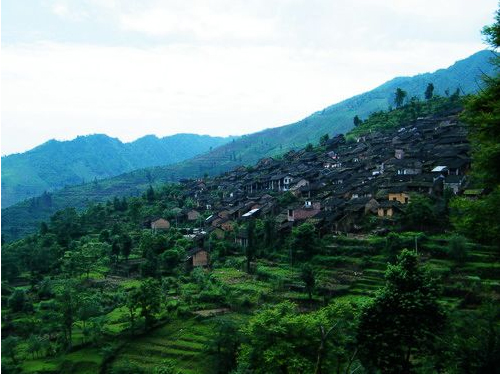 |
|
Lianshan is famous for its mountains. Mountains stand in front of houses and the roads are mountain roads.
|
Lianshan belongs to the low-latitude central subtropical monsoon climate zone, characterized by profuse rainfall, an annual average air temperature of 18.9℃, an average air temperature of 9.3℃ in January, 26.8℃ in July, 1758.1mm of average precipitation, an average humidity of 82%, 317 frost-free days in a year, a long summer, a short winter, large monthly range and daily range, and a mountainous vertical climate. Its soil is fertile and its vegetation is sound, suitable for agriculture, forestry and animal husbandry. Its main grain crops are paddy, corn and sweet potato. Its main cash crops are peanut, ginger, lotus root, sugar cane, Chinese wild yam and tobacco. Lianshan’s famous local specialties are honey, Shatian Pomelo, dried mushroom, lucid ganoderma, team oil, dried bamboo shoots and Yunwu tea. The county has established some fruit and agricultural leading enterprises in focus on ethnic food, bacon hogs, Dongshan goats and Shatian Pomelo, and set up organic paddy, ginger, Chinese wild yam, fruit, lotus root, sweet bamboo root, southern medicine and other characteristic agricultural product bases.
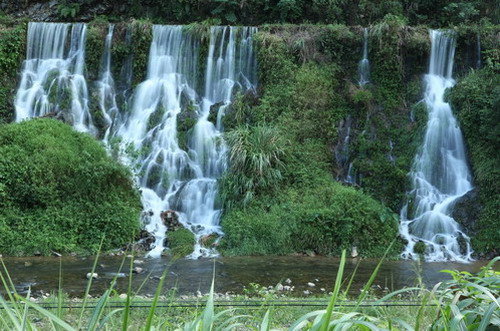 |
|
Lianshan is characterized by profuse rainfall, an annual average air temperature of 18.9℃, long summer and short winter.
|
Lianshan is a key forestry county in Guangdong. It has 1.557 million mu of woodland, including 551,000 mu of provincial-level ecological forests. The forest growing stock takes up 8.7384 million cubic meters. Lianshan’s forest coverage rate is 83.3%. It has established Bijia Mountain provincial natural reserves and five municipal natural reserves, including Tiantangling and Dafengkeng, and has taken the lead in the city to become a provincial-level forestry ecological county. Its vegetation is good. Its animal and plant resources are abundant. In the county, there grow 1,223 species of vascular plants under 612 genera and 201 families, including 140 species of ferns under 65 genera and 34 families, 29 species of gymnosperms under 10 genera and 10 families, and 1,054 species of angiosperms under 537 genera and 157 families. It has 21 species of rare and endangered plants, of which Bretschneidera sinensis, Taxus chinesis var mairei, gingko, cycad and camphor are grade 1 or 2 plants under national key protection. The county is also home to 236 species of terrestrial vertebrates under 70 families and 25 orders, 510 species of insects under 158 families and 15 orders, 34 species of rare and endangered animals, including clouded leopards, python sand pangolins, which are all grade 1 or 2 animals under national key protection.
 |
|
Lianshan is a key forestry county in Guangdong. The photo is taken at Bijia Mountain provincial natural reserve.
|
In the county, rivers crisscross each other, riverbed fall is large and currents are torrential. There are 194 rivers, including 9 rivers with rainwater harvesting area of above 100 square kilometers. Its total length is 274km. The rivers radiate in all directions and belong to the Xijiang River Water System and the Beijiang River Water System of the Pearl River Delta and the Xiangjiang River Water System of the Yangtze River. The reserves of water resources are 158,000kW and the exploitable reserves are 133,300kW. The county has 249 established small hydropower stations, with annual power generation capacity of 310 million kwh. It is one of the 400 electrification counties powered by hydropower in China. Its main minerals are gold, silver, copper, iron, crystal, quartz and kaolin.
Lianshan county enjoys an advanced traffic network and communications network. The No. 323 national highway runs through the Taibao, Jitian and Yonghe towns of the county from east to west, enters Liannan in the east and links Qinglian Expressway, which is being upgraded, and leaves Yingyangguan in the west and is accessible to Hezhou and Guilin in Guangxi. The No.263 provincial highway runs through Jitian, Futang and Xiaosanjiang towns from north to south and is accessible to Foshan and Guangzhou. The No.399 county highway starts from Hedong and is accessible to Jianghua and Changsha in Hunan. In 2007, the traffic mileage in the county was 801.2km. All village committees are accessible by motor vehicles. National highways, provincial highways and county highways are built on hard ground. Post and telecom networks cover all Zhuang and Yao villages. Post and telecom realize urban and rural integration. Telephone lines have been installed in every village. Water and power supply networks are sound and the supply is adequate.
The green mountains, beautiful waters, fascinating landscape, kind local people, rich Zhuang and Yao culture, abundant biological resources and good ecological environment in Lianshan are attracting more and more visitors these days. The county’s major tourist attractions are “Guangdong Jiuzhaigou” Daxu Mountain Waterfalls, “3-Province Border” historical gateway Yingyang Gateway, where people may have a bird’s eye view at the scenery of the three provinces, and the Fulinyuan Relaxation scenic spot where people may enjoy the folk customs and stunts of the Zhuang and Yao peoples.
 |
| Rafting in Bijia Mountain |
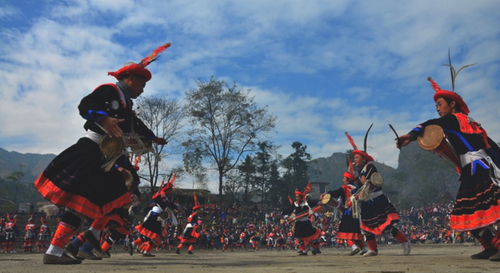 |
| Long drum dance of the Yao people |